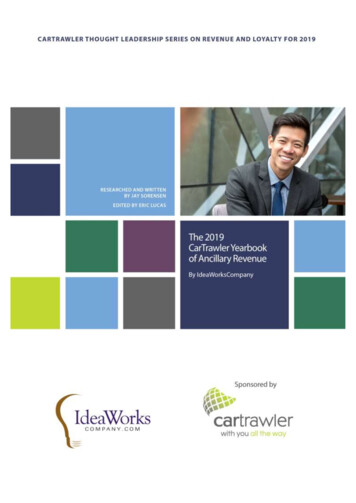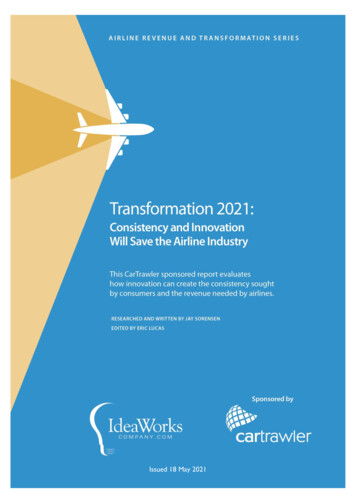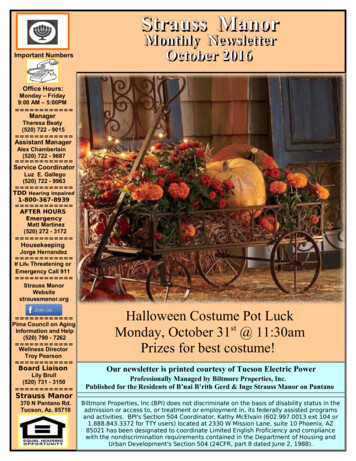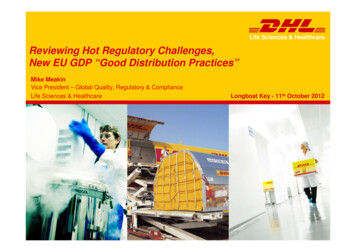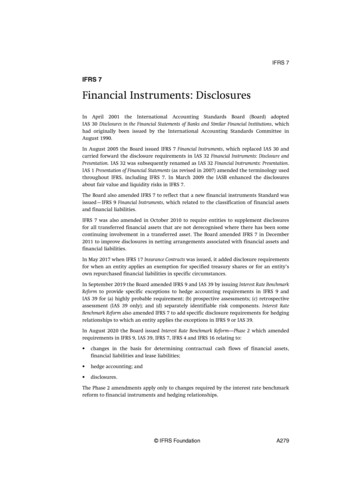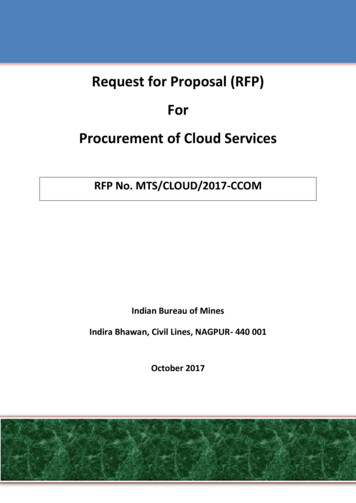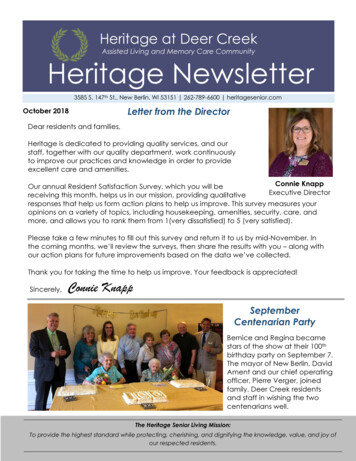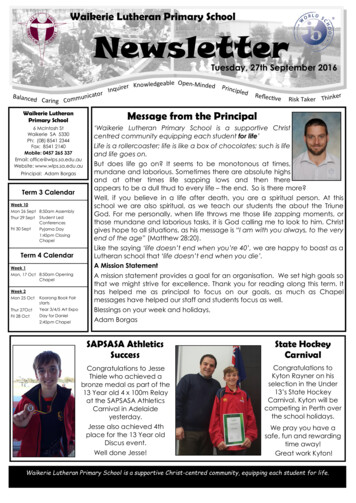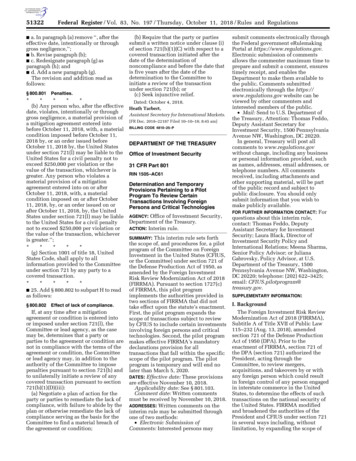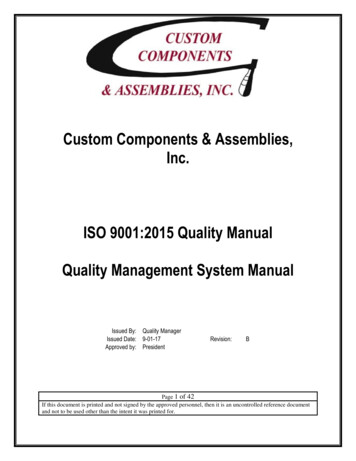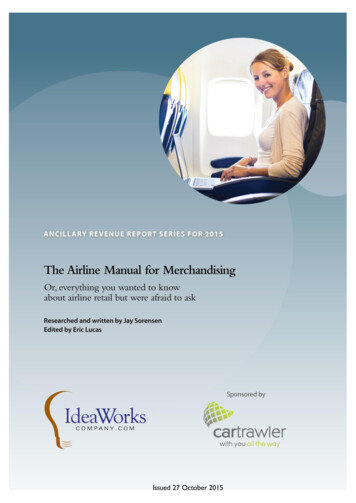
Transcription
Issued 27 October 2015
The Airline Manual for MerchandisingOr, everything you wanted to know about airline retail but were afraid to ask.ContentsThis report won’t tell you anything about Instagram . 4Ancillary revenue is the catalyst for airline retail change . 4Dynamic pricing will determine how optional extras are sold. 8Linking a la carte methods to GDS is the next frontier . 10Ryanair wants to become the Amazon.com of travel . 13The free distribution of this reportis made possible through the sponsorship of CarTrawler.Established in 2004 and headquartered in Dublin, CarTrawler provides aviation, travel,hospitality, leisure and consumer brands with a direct connection to over 1,300 leading andindependent car rental agents, shuttle bus companies, limousine and chauffeur drivenservices in over 30,000 airport and city locations across 174 different countries in thelanguage and currency of their choice. By satisfying customer demand for choice andconvenience, CarTrawler consistently delivers profitable growth for its partners. For moreinformation, visit cartrawler.com.Issued by IdeaWorksCompany.com LLCShorewood, Wisconsin, USAwww.IdeaWorksCompany.comManual for Airline MerchandisingIdeaWorksCompany.com LLC 2015Page 1
Manual for Airline MerchandisingIdeaWorksCompany.com LLC 2015Page 2
About Jay Sorensen, Writer of the ReportJay Sorensen‘s research and reports have made him aleading authority on frequent flier programs and theancillary revenue movement. He is a regular keynotespeaker at the annual MEGA Event, spoke at IATAPassenger Services Symposiums in Abu Dhabi andSingapore, and has testified to the US Congress onancillary revenue issues. His published works are reliedupon by airline executives throughout the world andinclude first-ever guides on the topics of ancillaryrevenue and loyalty marketing. He was acknowledgedby his peers when he received the Airline IndustryAchievement Award at the MEGA Event in 2011.Mr. Sorensen is a veteran management professionalwith 30 years experience in product, partnership, andJay, with sons Anton and Aleksei, onmarketing development. As president of thethe North Fork Trail in North CascadesIdeaWorksCompany consulting firm, he has enhancedNational Park in Washington.the generation of airline revenue, started loyaltyprograms and co-branded credit cards, developed products in the service sector, and helpedstart airlines and other travel companies. His career includes 13 years at Midwest Airlineswhere he was responsible for marketing, sales, customer service, product development,operations, planning, financial analysis and budgeting. His favorite activities are hiking,exploring and camping in US national parks with his family.About Eric Lucas, Editor of the ReportEric Lucas is an international travel, natural history and businesswriter and editor whose work appears in Michelin travel guides,Alaska Airlines Magazine, Westways Magazine and numerous otherpublications. Founding editor of Midwest Airlines Magazine, he isthe author of eight books, including the 2013 Michelin Alaskaguide. Eric has followed and written about the travel industry formore than 25 years. He lives in Seattle, Washington, where hegrows organic garlic and heirloom corn; visit him online atTrailNot4Sissies.com.Eric, at his favorite summer retreat, Steens Mountain, Oregon.Disclosure to Readers of this ReportIdeaWorksCompany makes every effort to ensure the quality of the information in thisreport. Before relying on the information, you should obtain any appropriate professionaladvice relevant to your particular circumstances. IdeaWorksCompany cannot guarantee,and assumes no legal liability or responsibility for, the accuracy, currency or completeness ofthe information. The views expressed in the report are the views of the author, and do notrepresent the official view of CarTrawler.Manual for Airline MerchandisingIdeaWorksCompany.com LLC 2015Page 3
The Airline Manual for MerchandisingThis report won’t tell you anything about Instagram.Neither will it describe Digg, Snapchat, or Livefyre. If you are engaged in the world of socialmedia you know about these things. But if you arelike many of us, the continuous pace of technologicalchange is simply overwhelming. You know and likelyuse Facebook, Twitter, and LinkedIn. But you mightnot be aware Instagram will probably surpass Googleand Twitter for mobile ad revenues in 2017.1 Andvery few of us can describe the methods associatedwith all 210 social media related services included inthe extremely busy image to the right.The same dizzying array of technology, methods, andbrands also occurs in the business of travelmerchandising. Dynamic pricing, branded fares, andNDC can be just as confusing for executives as theThe Conversation Prism categorizes morethan 210 of the world’s social media relatedworld of social media. The global airline industry isservices.Source: Brian Solis and JESS3predicted by IATA to post revenues of 763 billionduring 2015. At this level of activity, airlines are moving beyond the mere taking of ordersand are seeking to become world class retailers. This report intends to prepare industryprofessionals for the decision-making required to take airline merchandising to the nextlevel.Ancillary revenue is the catalyst for airline retail changeLow cost carriers, such as Ryanair, introduced websites about 15 years ago that had theappearance of being built by teenagers as a weekend project. The pages lacked graphicdesign charm, but were most assuredly powerful producers of online sales. The internetprovided the perfect disruptive platform for these LCCs to experiment with a la carteoffers. Consumers were invited to point and click through the booking process to fill theirtravel shopping carts. Back then, LCCs didn’t have a presence in global distribution systems.Their merchandising creativity was only limited by what they could build into their websites.The small and nimble culture of LCCs created the perfect environment for experimentationwith in-path offers, fare bundles, and annual product subscriptions.1“Instagram Mobile Ad Revenues to Reach 2.81 Billion Worldwide in 2017” article dated 27 July 2015 ateMarketer.com.Manual for Airline MerchandisingIdeaWorksCompany.com LLC 2015Page 4
Traditional airlines, such as United, Air France, and Cathay Pacific, were frustrated by thegrowing influence of LCCs. But these airlines were also fascinated by the benefit of using ala carte methods to sell travel direct to consumers. Hotel and car rental bookingcapabilities, along with selling exit rowseats for an additional fee, were earlywebsite features added by traditionalairlines.Ryanair’s home page from 2001was certainly plain and lackedcharisma, but boy-oh-boy it delivered big revenue.The fuel price crisis of 2008 requiredthe quick addition of new revenuesources. US-based airlines jumped onthe opportunity of baggage fees andthese were added as optional extras tobe booked at the website. Globaldistribution systems have been tryingto catch up since and only recently aremaking limited progress on creatingparity between what is sold on airlinewebsites and GDS screens.Source: Wayback.com.A la carte pricing has been used by airlines and the GDSs as a tool to gain leverage with theother party. Airlines have been pressured to make a la carte features available through GDSto meet the needs of business travelers. Corporate clients are demanding the ability tobook and pre-pay services such as checked bags and extra leg room seating beforeemployees begin their trips. GDSs indicate support for airlines to offer customer-specificpricing through the NDC process. That’s a big change from the current method in which aGDS assembles the selection of air fares based upon the booking request of the consumer.Prices can be a la carte, bundled, and even part of a familyGone are the days when a simple air fare represented the entire cost of an airline trip.Thanks to abundant low fare competition, consumers canchoose a travel style to meet their desires for price, comfort,and convenience. Those holding to old ways enjoy thecomfort provided by an all-inclusive fare. This has everyonepaying the same price even if they don’t want to check twobags, eat a hot meal, and accrue the full measure of frequentflier miles.All-you-can-eat buffets are great for those with big appetites,but don’t offer value for those looking for salad or a cup ofsoup. That’s the beauty of the a la carte method; consumersare free to choose what they want when airlines sell air travelas components. Too many government regulators want toforce the industry back into the analog-style method of settinga single price. That would be the same as requiring a grocerto define the final register total before a shopper enters theirstore.Manual for Airline MerchandisingShopping for travel should besimilar to filling a cart at agrocery store. This cart is filledwith a Sorensen kid from 2005.IdeaWorksCompany.com LLC 2015Page 5
Even the simplicity of a basic fare with a la carte extras has given way to bundling andbranded fares. That was the approach once favored by Wizz Air. Visit the carrier’s websitetoday and you will see a robust display of various pricing methods (see image below).Consumers first choose from two branded fares, which have the eloquently simple names ofBasic and Plus. Icons readily display the features associated with each, with Basic onlyproviding online check-in and permitting a small carry-on. These qualify as branded faresbecause the price premium of Plus over Basic is set at a consistent amount. For example, inthe Madrid – Budapest market, the Plus premium is consistently 62.In addition, the Basic fare does not sell out as the aircraft fills up and remains on-the-shelf intrue retail fashion. Branded fares allow consumers to upgrade their experience. Travelersdon’t always seek the lowest fare; asurprising number willingly pay apremium for more comfort andconvenience. JetBlue implemented abranded fare strategy in 2015 andexpects it to produce annual revenuegains of 200 million.2 Managementknows a significant number of JetBluepassengers choose the carrier’s BluePlus or Blue Flex fares in lieu of thelowest priced Blue fare. Many will pickthe Blue Plus fare simply because it’s the“middle” choice.Jetstar doesn’t have branded fares, butuses a similar approach that’s simplycalled service bundling. Rather thanpublish distinct fares, the bookingsystem offers a “Starter Fare” and theoption to consider two additionalpackages of features and amenities.2The above displays an excerpt of the features associated withthe service bundles offered by Jetstar. The Plus bundle has aconsistent premium while the Max bundle premium varies.JetBlue Investor Day Presentation 19 November 2014.Manual for Airline MerchandisingIdeaWorksCompany.com LLC 2015Page 6
Fare families represent a less sophisticated method that attaches features to existing faresthat are tiered for revenue management purposes. For example, TAP Portugal offers foureconomy fare products: Discount, Basic, Classic, and Plus. The fares are associated withspecific features for change fees, mileage accrual, priority screening, assigned seating, andothers. But these are not branded fares, because lower priced fares do sell out whichremoves the availability of that particular product.Unfortunately, a very full flight might only offer the top-priced Plus fare. This violates aprimary rule of merchandising always have products available on the shelf for sale. Forfare family pricing, the differences between the fares vary and are not placed at predictableprice point premiums. For consumers, this could be a modest 30 or an outrageous 300.The following table summarizes the most popular types of airline pricing:Table 1: Popular Types of Airline PricingTypesDefinitiona la Carte(unbundled)Consumers may addLower priced fares sell outoptional extras such asas demand increases, butchecked bags, assignedoptional extras remainseats, and pre-order mealsavailable.to any fare.Base fare provides minimalamenities and consumersBranded Fares may upgrade to higherpriced fares that offermore perks.ServiceBundlesRevenue ManagementEach fare type is alwaysavailable and has a fixed(predictable) pricepremium.Airline ExamplesWizz Air’s optionalservices such as priorityboarding, extra leg room,and assigned seats.Wizz Air’s Basic and Plusfares; and JetBlue’s Blue,Blue Plus, and Blue Flexfares.Base fare provides minimal Bundles are always availableJetstar’s Starter Fare and itsamenities and consumersand may have fixed pricePlus (fixed premium) andmay purchase packages thatpremiums or areMax (dynamic) bundles.offer additional perks.dynamically priced.Lower dynamically pricedAmenities are linked tofares sell out as demandexisting fare categories,Fare Familiesincreases, which limits thewith higher fares providingchoices presented tomore perks.consumers.TAP Portugal’s Discount,Basic, Classic and Plusfares.Discount is applied toClub membership allowsUnited’s subscriptions forlowest available fares.consumers to enjoy farebags and Economy Plus;SubscriptionService features are usuallydiscounts or have access toand Volaris V-Club fareprovided withouta service feature.discount program.limitation.Sources for Airline Examples column: Websites visited September 2015.Subscription plans are becoming an engaging method for more airlines and consumers.United Airlines has been a leader with annual subscriptions for checked bags, Economy Plusseating and airport lounge access. Sometimes the subscription doesn’t provide a service,but offers access to special pricing or discounts. Volaris Airlines, an LCC in Mexico, sells VClub membership for 49 (or 499 pesos) which promises access to best available fares.Manual for Airline MerchandisingIdeaWorksCompany.com LLC 2015Page 7
Volaris has done very well with its club. Revenue from the subscriptions, which also includea 6-person group plan, provided 3.5 million for the airline in 2014.3 There were 108,000V-Club members at the endof 2014, which more thandoubled 2013 membership.There is an average of 2.5travelers enrolled per clubmembership.4 The airlineuniquely offers a 500 planfor small and medium-sizedenterprises. V-Clubroutinely delivers 10% offEvery booking at Volaris.com provides a reminder of the savings offered by thethe base fare, a low-season V-Club program by displaying the club fare next to the regular price.discount of 20%, and one-day advance access to fare sales.5Beyond the annual fee is the revenue magic provided by the repeat purchase of tickets.Volaris.com automatically becomes the first website visited for anyone shopping for travel.Members have made an “investment” in the relationship with the airline; this represents aloyalty that’s stronger than any frequent flier program. The carrier’s premium co-brandedcredit card includes V-Club membership. Imagine the power for airlines that offersubscription plans combined with frequent flier benefits and a co-branded credit card. VClub savings are dynamically generated by revenue management and vary by flight.Dynamic pricing will determine how optional extras are soldPricing is not only defined by fare families, branded fares, and service bundles, but also bythe method used to calculate the fare itself. This refers to the art of revenue management.Contrary to popular belief, it doesn’t seek to raise fares to their highest level. But rather,to maximize the revenue produced by an individual flight departure. Fares which varyaccording to demand, and are adjusted through revenue management are “dynamicallypriced.” Sophisticated analytics, which may include demand forecasting, are used to offerthe optimum fare to a consumer’s query. Revenue management has been part of theindustry for decades. The newest opportunity uses dynamic pricing to maximize ancillaryrevenue.There is confusion in the industry regarding dynamic pricing and optional extras. Pricesassigned to simple attributes such as flight number, seat location, or calendar period, don’trepresent dynamic pricing. But when a combination of these factors is used to build a price– and the process is largely opaque to consumers – this qualifies as dynamic pricing. It hasbeen reported Ryanair has applied dynamic pricing to baggage fees. This is technicallyuntrue; Ryanair merely charges different fees according to its low and high season calendar.Flexible or conditional pricing varies a la carte fees according to choices made by theconsumer. It’s a method viewed by the industry as being very revenue savvy, and is quicklyreplacing one-size-fits-all prices for a la carte items.3CarTrawler Yearbook of Ancillary Revenue by IdeaWorksCompany, September 2015.Volaris January 2014 presentation at the Banco Santander - 19th Annual Latin American Conference.5Information provided by Volaris commercial department September 2015.4Manual for Airline MerchandisingIdeaWorksCompany.com LLC 2015Page 8
Spirit Airlines offers a very eloquent display offlexible pricing for assigned seating (see image atleft). Consumers may pick their seat during thebooking process from a seat chart of prices. Otherairlines provide a color coded map with prices listedunder a legend. But the message from Spirit iscrystal clear to the consumer . . . the mostpreferred seat assignments at the front of the cabinor in the exit rows have a premium price attached.Spirit’s “pick your seat” display for a Chicago –Fort Lauderdale October 2015 flight.The use of dynamic pricing to set a la carte feesremains rare. United makes extensive use ofrevenue management for its FareLock feature.Consumers pay a fee, which ranges from 6.99 to 35, to hold a fare for three or seven days.6 Unitedminimizes its risk by only offering FareLock on flightsfor which the probability of reselling the seat is high.United doesn’t display the padlock-style icon forflights having a high risk of seat spoilage.United admits in financial disclosures it uses dynamicpricing for its Economy Plus product, which provides passengers an extra 3 to 5 inches ofleg room.7 According to the fee disclosure at United’s website, prices for Economy Plusrange from 9 to 299 per flight per person. Reviewing the below image from a Unitedinvestor presentation demonstrates Economy Plus is most definitely not priced as a flat fee.This image was prepared by United for a 24 February 2015 Investor Presentation to demonstrate the range ofextra leg room upgrade prices available on a Tokyo – Chicago routing.67“Changed bag rules and optional services” page at United.com reviewed September 2015.United aircraft specifications at SeatGuru.com reviewed September 2015.Manual for Airline MerchandisingIdeaWorksCompany.com LLC 2015Page 9
United has applied a diversity of pricing for extra leg room seating that’s comparable to thefares offered on a flight. The carrier’s revenue management efforts are providing realrewards, as revenue per Economy Plus seat was up 16 percent for the first quarter of 2015compared to the same quarter in 2014.8 The following table provides a definition ofdynamic pricing, along with the other two most popular methods used for optional extras.Table 2: Defining Pricing Methods for a la CarteMethodDefinitionAirline ExamplesDynamic orRevenueManagedPrices are determined at the time aconsumer requests the product. Theairline sets prices based upon anevaluation of demand and supply using acombination of factors unique to eachbooking request.United relies on revenue management todetermine when to offer FareLock toconsumers at its website. In addition,pricing for its Economy Plus product isdynamically determined.FixedOne price is applied for an a la carteservice across an entire airline.Variations may occur due to currencyconversion. The consumer can easilydetermine fees based upon disclosures.Tigerair sells early boarding for SGD 6;Azul charges 100 for unaccompaniedminors; and Flydubai will check a 20kgbag for AED 50.Flexible orConditionalChecking a 1st bag using Ryanair.comFactors, which are disclosed toduring the low season costs 15; for theconsumers, are applied to determine fees. high season it’s 25. Spirit charges fromThis may include length of flight, advance 26 to 100 for a large carry-on bagpurchase, travel period,depending on when and where the item ispaid.Sources for Airline Examples column: Websites visited September 2015.Regulators may be surprised by the increased use of dynamic and flexible pricing methodsfor a la carte services. The trend away from fixed prices reflects the industry’s desire tobecome better retailers. Airlines would help ease the transition for consumers if theyprovided more clarity on how prices are determined. Simply disclosing a range of pricessuch as “ 6.99 to 35” or “from 15” may meet minimal regulatory requirements, butdoesn’t inspire consumer confidence in the ethics of ancillary revenue.Linking a la carte methods to GDS is the next frontierAs described earlier in this report, airlines have mastered, or are making great progress inthe art of online retail. The direct channels for an airline were once call centers and cityticket offices. These channels do remain, but are completely eclipsed by the direct channelof a carrier’s website. In a 2012 report commissioned by IATA, airlines are expected toproduce 59 percent of their booking volume through their websites by 2017; this wouldrepresent a sizeable increase from the 35 percent generated by airline websites in 2012.989United Continental 1st quarter earnings call on 23 April 2015.“The Future Of Airline Distribution” by Atmosphere Research dated 05 December 2012.Manual for Airline MerchandisingIdeaWorksCompany.com LLC 2015Page 10
This market share shift to airline websites still leaves global distribution systems with atremendous volume of business, and a dominant position in the corporate travel market.Access to this market defines why airlines and GDS companies are compelled to cooperateon the topics of branded fares and the sale of optional extras. However, Lufthansa Grouprecently surprised the travel industry by implementing a “distribution cost charge” of 16for every ticket booked through a GDS.10 The fee is not applied to bookings made atLufthansa Group websites to include its new online portal for travel agencies. Lufthansaadmits these moves are designed to shift bookings from GDS channels.Employers want to pre-pay these fees to maintain better control of travel expenses. Inmany cases, this only occurs if a la carte services can be booked through a GDS. Thesesystems are said to operate on legacy platforms that can’t fully accommodate the need formerchandising flexibility. This has caused airlines to delay implementation and complain theycan’t properly merchandise their a la carte services to travel agents. Progress is being made,but is hampered by the chaos of the complex methods described throughout this report.The earliest efforts to align direct and indirect travel retail began by establishing standardsto enable the technologies to interact. The Airline Tariff Publishing Company (ATPCO) isresponsible for processing fare filings for airlines all over the world. ATPCO standardizedthe filing of a la carte fees during 2008 with its optional service solutions.11 This gave airlinesan early solution to file fees for distribution on different platforms. IATA advocated forcommon standards, such those represented by Electronic Miscellaneous Documents (EMD)and the far more crucial NDC, to enable communication between systems. It’s allaccomplished using bits and bytes with a myriad of computer systems working togetherbehind the scenes.The EMD type A is “associated” or linked to an individual passenger e-ticket (such aschecked baggage), which allows the airline to quickly tally a la carte revenue after the flight iscompleted. The EMD type S is designed as a “stand-alone” purchase voucher for servicesbought by a consumer but not linked to a particular passenger itinerary, such as thepurchase of a gift card.IATA coordinated the adoption of a standard among its member airlines. EMDs allow travelagencies to process payment for various airline services such as a la carte options anddeposits for group travel. But most importantly, they enable these transactions to occur ina digital format to allow airlines to track a la carte activity from the moment an item is soldthrough the time of delivery to a consumer. EMD provides a path to support the majorityof a la carte transactions processed by global distribution systems.The New Distribution Capability (NDC), commonly known as IATA Resolution 787,describes a framework to enable the merchandising of a la carte services through a GDS oronline travel agency. IATA changed the name to Enhanced Airline Distribution, but theNDC acronym prevails in popular use. At the core of Resolution 787 are four newmandates (paragraph 1.2.5) which IATA boldly calls to be incorporated into each GDS aslisted in Table 3 below:1011“Lufthansa redirects commercial strategy” press release date 02 June 2015 at LufthansaGroup.com.Optional Services Industry Fact Sheet reviewed September 2015 at ATPCO.net.Manual for Airline MerchandisingIdeaWorksCompany.com LLC 2015Page 11
Table 3: Resolution 787 Mandates for GDSs Allow individual carriers to determine their own prices and the nature of thoseproducts offered, depending on who the requestor is and what they are requesting. Facilitate the implementation of a “shopping basket” capability concept allowing forthe consumer to add or remove items from their basket as they choose. Each ofthese choices can trigger a “re-pricing” of the offer(s) provided by the airline. Support distribution of new products as well as changes and amendments of existingorders. Facilitate a transparent display of products being offered and enable comparisonamong different products, benefiting the consumer.Source: Resolution 787 Enhanced Airline Distribution at IATA.org reviewed September 2015.These are major changes because it takes the pricing function out of the GDS and makes itthe responsibility of the airline through its own passenger service system (PSS), pricing andmerchandising engines. The GDS becomes a conduit for the pricing actions of the airlineand actually identifies the consumer to the airline. These dramatic changes may force aGDS to reexamine existing system architecture and workflow processes to provide theflexibility demanded by Resolution 787, airline clients, and travel agency partners.Technology companies such as Datalex, Farelogix, and OpenJaw, have stepped into the frayto build technological bridges between airlines, booking engines, passenger service systems,and the GDSs.The outcomes that will someday occur through Enhanced Airline Distribution will be asdisruptive as variable pricing was decades ago. The airline industry, and most notablyAmerican Airlines, is largely credited with pioneering the concept of yield management12which is recognized today as revenue management. The practice of offering prices throughautomation – based upon demand and supply algorithms – is now commonplace in manyindustries. Revenue management is poised to be followed by yet another major innovationthrough the personalized pricing enabled by NDC. This method offers the capability tocombine revenue management and the attributes of individual consumers to deliverpersonalized pricing.Let’s describe this development using potential applications. A consumer visits an onlinetravel agency such as Expedia.com. The name, email address, and geolocation of theconsumer is noted by the website and passed to the airline through the NDC process. Thedata is evaluated by the airline and a lower fare is offered because the geolocation indicatesa lower income neighborhood and the consumer’s identity suggests a first-time customerfor the airline. In another example, a self-employed business traveler requests a reservationthrough a corporate travel agency. Similar information is collected and passed to the airline.This traveler receives a bundled offer (for essentially the same trip) with a checked bag,priority boarding, and bonus miles, because the airline knows the consumer’s travel historyand elite status . . . all courtesy of information contained in the carrier’s frequent flierdatabase.12“Interview: Former American Airlines CEO Robert Crandall” in Business Travel News dated 17 January 2014.Manual for Airline MerchandisingIdeaWorksCompany.com LLC 2015Page 12
The pricing process could morph from being based upon demand and supply to one whichadds the element of “willingness to pay.” From an airline perspective, this is veryintoxicating stuff and creates an automated pricing environment unlike any other in theworld. It’s rather similar to the car salesperson who evaluates a customer in the showroombefore offering a deal. Consumers need not immediately brace for these changes, as theindustry is years from implementing this style of personalized pricing. But if the history ofrevenue management can be considered a reliable predictor, one can imagine personalizedpricing will eventually find a home in the airline industry and later be embraced by otheronline retailers.Ryanair wants to become the Amazon.com of travelThis report began with a trip back in time with a display of the 2001 version of Ryanair’swebsite. The world’s leading low cost carrier has made amazing advances in the promotionand distribution of its airline product. Gone is the website which IdeaWorksCompany oncecheerfully described as representing “Vegas-style glory with blinking Christmas lights, anarray of fonts, a
Manual for Airline Merchandising IdeaWorksCompany.com LLC 2015 Page 5 Traditional airlines, such as United, Air France, and Cathay Pacific, were frustrated by the
